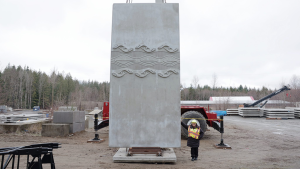The rising popularity of green buildings is leading some builders and property owners to shadow official third-party standards without seeking actual certification.
TORONTO
The rising popularity of green buildings is leading some builders and property owners to shadow official third-party standards without seeking actual certification.
Never in the history of modern building has so much attention been paid to the environmental aspects of the envelope, and contents such as solar panels, green roofs, waste water diversion systems, energy-efficient lighting and heating, waterless urinals, wood from stewardship forests, and use of recycled materials.
Interest in green buildings is so strong, says Peter Busby, vice-chair of the Canada Green Building Council, which administers Leadership in Energy and Environmental Design in this country, that some proponents have begun to shadow the program without actually registering for certification.
Busby, an architect with Busby Perkins + Will in Vancouver, acknowledges that he wishes the parties would register, but says he isn’t overly concerned and even sees indirect benefits.
“Our mission is to get people to do green building. The fact that they’re copying and shadowing and using our tools is actually getting us closer to our goal. So, we’re only mildly concerned. Even though they’re not doing it the way we want them to do it, at least they’re doing it.”
Busby says copycats include government and large institutions.
“Sometimes we’ll speak to people, particularly government authorities, who are using the LEED standard, but not pursuing certification. We tell them about the advantages of third-party verification and encourage them to seek it.”
While many imitators do fine work — Busby says some have demonstrated a clear commitment to sustainability and are producing relatively green buildings — he considers standards vital to ensuring high quality and authenticity.
“LEED offers independent certification. It’s not just what the salesman says. A third party has looked at the materials presented by the design team, the contractor and the owner.”
The way forward, Busby suggests, is to continue to refine LEED to maximize its green potential, and make it as easy and inexpensive as possible to register.
“We’re working on the next version of LEED at the moment,” Busby says. “We need to develop fewer prescriptive solutions and more performance-driven standards. We’ll look at having objectives — say for energy efficiency — and give designers the flexibility to design around these, and come up with their own solutions.”
Peter Semchuk, an architectural technologist with IBI Group in Edmonton who is LEED-accredited and a past-president of Construction Specifications Canada, says LEED Lite, as the copycat phenomenon is referred to informally, sometimes occurs with higher-end residential and condominium developments, and sometimes with suburban office space.
“There’s a real promotion of energy-efficient electrical and mechanical systems, natural daylight, operable windows, recycled content — a lot of items that are universally understood to be green by the general public.”
Like Busby, Semchuk has mixed feelings.
“Anything we can do to make buildings more sustainable and energy efficient is a good thing. But, the pitfall is a lot of people are saying they’re sustainable when this might not be the fact. You have to go through the process of quantifying the sustainable initiatives and green design that it’s reaching in order to say you’re LEED.”
Jonathan Westeinde of Westmill Developments, an Ottawa firm specializing in green projects, says what used to be considered green pales in comparison to current and evolving standards.
“Historically, a green building was thought to be something where you slapped a photovoltaic cell on the roof,” Westeinde says. “Now, it’s about a conservation-oriented design that maximizes the efficiency of systems in an integrated way. Increasingly, we’re understanding that a green building is an all-encompassing thing.”
Westeinde says he would like to see certification programs add life-cycle costing that considers the entire life span of a building and its base materials, rather than simply recognizing individual green features.
“What’s needed,” he explains, “is a cradle-to-cradle approach.”
Is there room for government intervention and legislation of green building standards? Wayne Trusty, who has been active with LEED programs in Canada and the U.S. and is president of the Athena Sustainable Materials Institute, a non-profit organization that produces data sets and software to help assess the environmental impact and life-cycle of building products, says governments already establish minimum standards through building codes and appliance rating systems such as Energy Star.
“We may see more high-performance things built into building codes and become requirements, but building codes aren’t the best — they’re the minimum,” Trusty says. “We aren’t a command-and-control world in North America. This will depend on appetite and political will.”










Recent Comments
comments for this post are closed